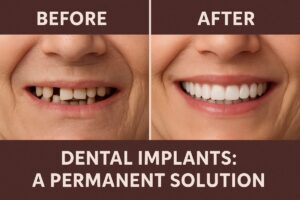Permanent implants, often hailed as a modern marvel in dental technology, provide individuals with a robust and enduring solution for missing teeth. Engineered from biocompatible materials such as titanium or zirconia, these implants fuse seamlessly with the jawbone through a process known as osseointegration. This integration establishes a stable foundation for dental prosthetics like dental crowns, dental bridges, or dentures. The durability and functionality of permanent implants significantly enhance the quality of life for patients, offering a natural feel and appearance. Moreover, since these implants can last for decades with proper care, they represent a wise investment in one’s oral health. With growing advancements, permanent implants continue to be a favorable choice for those seeking a reliable, aesthetic replacement for lost teeth.
Understanding how permanent implants are placed is crucial for those considering this dental solution. The procedure typically unfolds in multiple stages, beginning with a comprehensive assessment of the patient’s oral health. During this stage, the dental professional evaluates bone density, gum health, and overall suitability for the procedure. Following approval, the implant is surgically positioned into the jawbone, where it requires time to integrate. Once osseointegration is complete, an abutment is attached, onto which the final prosthesis is secured. This meticulous process ensures that the implant offers not just functionality but also aesthetic harmony with the existing dentition. Patients can expect a period of healing and follow-ups to monitor progress and ensure successful integration.
Patient Preparation and Aftercare for Optimal Implant Success
Before proceeding with a permanent implant, a detailed pre-treatment assessment is essential. This includes diagnostic imaging and a thorough review of the patient’s medical history to mitigate any potential risks. Dentists may suggest preliminary procedures, such as bone grafting, if there is insufficient bone density. Thorough preparation, including addressing any existing oral health issues, sets the stage for a smoother implant experience. Additionally, patient education plays a critical role in ensuring informed decisions, with dentists providing insights into the process, recovery, and maintenance of permanent implants.
Post-procedural maintenance and care are pivotal to the long-term success of permanent implants. After placement, patients must adhere to a routine that includes regular dental check-ups and consistent oral hygiene practices. This involves brushing, flossing, and possibly using an antiseptic mouthwash to prevent infections. Dentists typically recommend dietary cautions to avoid compromising the newly placed implant. Regular follow-ups allow dental professionals to assess healing, address any complications early, and ensure that the implant remains secure and functional. By maintaining diligent care, patients significantly enhance the lifespan and performance of their permanent implants.
The Lasting Advantages and Innovations in Implant Procedures
Permanent implants offer an array of long-term benefits that extend beyond aesthetics. One significant advantage is the preservation of jawbone health, as implants stimulate bone growth, preventing the bone loss associated with missing teeth. This aspect distinguishes implants from traditional dentures, which can sometimes accelerate bone resorption. Additionally, permanent implants allow patients to eat, speak, and smile with confidence, closely mimicking natural teeth. Other long-term considerations include the initial financial investment versus the associated benefits over time, as implants often eliminate the need for further dental work that temporary solutions might require.
Technological advancements have also reshaped the implant procedure, providing patients with enhanced comfort and convenience. For instance, sedation options like nitrous oxide and oral conscious sedation, often offered by experts such as Dr. Painter, make the procedure more pleasant by minimizing discomfort and anxiety. Additionally, patients benefit from financial options, with many practices offering financing plans and working with various insurance providers to make implants more accessible. These innovations ensure a better overall experience, facilitating a smooth journey from initial consultation to final placement and long-term care.
Navigating Your Permanent Implant Journey with Expertise
Common questions about permanent implant procedures often revolve around aspects such as candidacy, recovery time, and success rates. It is crucial for dental patients to engage in meaningful discussions with their dental care providers. This dialogue helps dispel uncertainties and set realistic expectations concerning the procedure and outcomes. Equipped with comprehensive information, patients can anticipate the various stages of the implant process and understand their roles in ensuring a successful outcome. Here at Sedation & Implant Dentistry, we ensure that your journey is as transparent and supportive as possible, offering you the clarity and peace of mind you deserve.
At Sedation & Implant Dentistry, our team, led by Dr. Painter, merges skill and advanced techniques to deliver exceptional implant solutions. Leveraging years of expertise and cutting-edge technology, we are committed to transforming lives one smile at a time. Whether it’s selecting the right sedation method for comfort or navigating financial options, we focus on patient-centric care. Your comfort, satisfaction, and oral health are our top priorities, ensuring that your experience with us exceeds expectations. Are you ready to restore your smile at our skilled and trusted dental practice? Don’t wait to get the smile of your dreams with us. Get in contact with our doctor, Dr. David Painter, and our exceptional team at our practice to schedule an appointment today!






